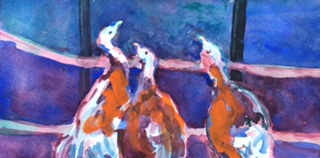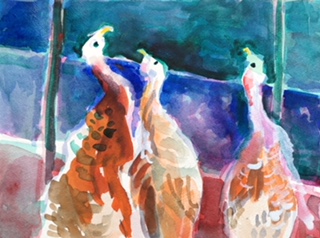This year the workshop will be entirely different in focus from years past. The focus will be on the brush and the marks they make naturally. The marks from a single brush is dependent upon how it is filled with paint or ink, how it is held and moved. The brush marks can be individual to each person. Their desires, skills as well as the paints and surfaces they choose enters into the results. The numerous ways the brush is handled is like a vocabulary is to the writer.
Brushes are advertised as if each brush has a single purpose like liner, blender, mop, round pointed for detail, or long ones for calligraphy. If limited to their advertised label, their full range of natural mark making characteristics are missed. Perhaps the advertising labels are to get more sales. For example, the number 1 liner made by the Princeton Art and British Co. has extraordinary possibilities. When the entire length is rolled in wet fluid watercolor or ink so it holds its maximum capacity, it is capable of making a line that goes, goes and goes increasingly thin and faint.
If the 1/8" wide by 3/4" long liner is swiped sideways along its length it makes shapes.
Many lines close together make textural shapes. These two methods are among many ways to use a single brush type. For me personally, getting to know a brush is a springboard to abstracting the subject as well as revealing a story of how the painting was made. Secondly, as I become familiar with a brush, I feel how it might be expressive of how I feel about a subject.
My fourth painting of "Turkeys in the City" has just a few different
uses of the liner brush other than the usual use of it for the rigging on ships or tree branches. The open spaces between the brush strokes makes it easy for me to make major corrections even as the painting is near completion. I just noticed the heads of the turkeys are too large.
The third painting of Wild Turkeys in the City was painted with a number 12 round Kolinsky Legend brush made from the tail hairs of Russian mink ( in last week's blog I wrote incorrectly that it was sable.) Because it comes to a point it makes good curved feather-like strokes. Also the large brush makes nice big washes. The signature characteristic of the big Kolinsky brush is the round corners from ample wet color stored in the many hairs in the brush's rounded bowl.
 The first turkey painting to the right consists of a build up of layer upon layer of washes using the the 1/2" Simply Simmons 1 stroke plat long . During the process I would put a wash on and then leave it to do some mundane household task, coming back for another wash when the painting was completely dry. I became fond of this synthetic hair brush. In this painting I felt it was forced
The first turkey painting to the right consists of a build up of layer upon layer of washes using the the 1/2" Simply Simmons 1 stroke plat long . During the process I would put a wash on and then leave it to do some mundane household task, coming back for another wash when the painting was completely dry. I became fond of this synthetic hair brush. In this painting I felt it was forced  In the second painting of turkeys using the Simply Simmons 1/2 inch flat, my initial drawing in paint did not go well, so on subsequent layers I was able to draw a new outer edge of the turkeys' heads. The right angle of the brush's tip lent itself to making angular shapes in the drawing and in filling in the background helping to unify the paintings. The lighter early drawing left a nice transition from the very dark background to the very white of the head giving the head a three dimensional form.
In the second painting of turkeys using the Simply Simmons 1/2 inch flat, my initial drawing in paint did not go well, so on subsequent layers I was able to draw a new outer edge of the turkeys' heads. The right angle of the brush's tip lent itself to making angular shapes in the drawing and in filling in the background helping to unify the paintings. The lighter early drawing left a nice transition from the very dark background to the very white of the head giving the head a three dimensional form.  |
| Branch with Fruit, Shih T'ao, Ch'ing period |
The Chinese letter shapes are composed of a number of specially designed brush strokes. The form of alphabets made by the brush are formed in the character of what brushes will do. The letters made by a pen nib and brushes repeated many times take on the different characteristics of the tool that made them.
Writing with pen or brush also take on the personality of the writer. I want to extend the personal touch to my own painting and inspire students towards their own style in the use of the brush.






2 comments:
that sounds like it'll make a really interesting workshop.
I hope to have more content for returning students. Soon I must focus on making a stimulating grab bag for anyone needing inspiration for what they can paint. I am not setting up things to paint.
Post a Comment